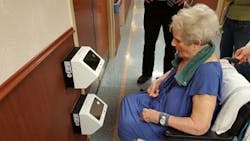Princeton Identity upgrades access control system with biometric iris recognition at elder care facility
Erie, PA (December 1, 2016) – Princeton Identity has recently implemented an iris recognition system at Brevillier Village, a long term care and independent residential/retirement facility in Erie, Pennsylvania, that will make access control procedures easier and more convenient for both residents and staff.
According to Jean LaFuria, Vice President of Residential Services, Brevillier Village, there were problems on-site when residents had difficulty using the access control keypads to move about the facility. A variety of options were investigated, including larger keypads to increase visibility, but none were an ideal solution.
“Adding key cards to solve the problem was not an option because of liability/legal issues and larger-sized pin pads were only a partial solution,” adds LaFuria. “We were already using fingerprint technology for staff time and attendance but it was less viable for the residents, and created new concerns for accuracy and transmission of germs. After researching current technologies, we learned that iris recognition could be an ideal solution for us – it is highly accurate, non-contact, and eliminates the need to remember codes. The easy-to-use iris recognition technology from Princeton Identity was the answer for our challenges.”
The solution from Princeton Identity involved adding two of their IOM (Identity on the Move™) Walk-Through Identity systems and six IOM Access Control readers in the personal care building. IOM readers are installed on four sets of doors at two heights – a lower position for those in wheelchairs and a higher position for those who can stand or use crutches or a walker. Once enrolled, users simply glance at the iris reader without having to remove glasses or place their eyes close to the device. Authentication is confirmed in less than a second, and the door can be opened. Because of the system’s ease of use and reliable accuracy, the staff at Brevillier Village are also enrolled in the system. The building’s previous access control system was left in place as a back-up.
“This project highlights some of the advantages of iris recognition in healthcare and assisted-living applications,” said Mark Clifton, CEO, Princeton Identity. “Many facilities need to support users with a wide range of physical limitations and challenges. Iris recognition is a great fit for these cases because it is fast and easy for users, doesn’t require a free hand, and maintains safety and security.”
For more information about Princeton Identity visit www.princetonidentity.com.


